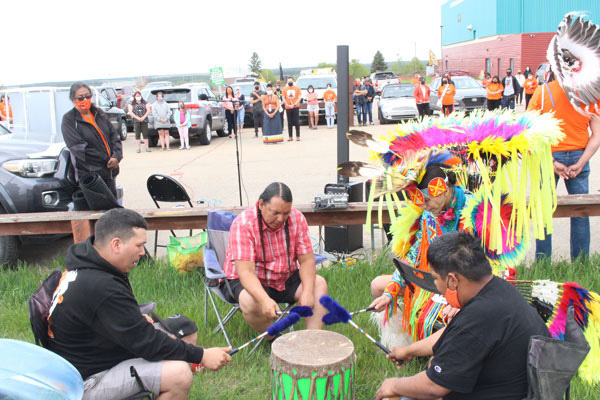
In response to the discovery of the remains of 215 children which were discovered on the grounds near the former Kamloops Indian Residential School on Tk’emlups te Secwépemc First Nation in British Columbia, the Prince Albert Grand Council (PAGC) held a prayer vigil to show support to the community and others affected by the Indian Residential Schools in PAGC’s communities on Monday.
According to one of the organizers of the service Gordon Mirasty it was to bring awareness to what happened in residential schools and for understanding of what happened at the schools in Canada.
“A lot of people came together as soon as they heard about it just to honour the children that never went home to their families but they also came for their own feeling to learn more about what happened in these schools,” Mirasty said.
“With everyone across Canada doing a commemoration we wanted to be a part of that commemoration,” he added.
The prayer vigil was at the site of the former Prince Albert Residential School called All Saint’s or later the Prince Albert Indian Student Residence, which Mirasty attended from 1960 to 1969.
“It bothered me that all of Canada and the churches and the government knows what they did to many of us including me. I want healing to begin, I want Canada to acknowledge and take responsibility for what happened. Not the compensation but start saying I’m sorry we did all of these things through government policy,” Mirasty said.
Among the speakers was PAGC Vice Chief Joseph Tsannie. He called on governments to work with First Nations.
“On behalf of the Prince Albert Grand Council we want to call on the governments to do the right thing, to make sure everybody is held to account, making sure those residential sites that are out there, making sure that they are scanned properly and try and find those missing children that never came home,” Tsannie said.
Council Support Worker for PAGC and Elder Gordon Keewatin, who performed the smudge before the ceremony, explained that the vigil was also to show support for all residential school survivors.
“It is very important because many of them never made it home and many parents never knew where they were, they lost them and today those answers were never given, they weren’t given a proper answer and this is how they find out by finding graves for their loved ones. It is sad to say but we have to show recognition with what we are doing here today to show that we support everything that the people are feeling because we have a lot of survivors that are impacted or triggered by what happened just recently,” Keewatin said.
Keewatin himself is a survivor of two residential schools in Portage La Prairie and Birtle, Manitoba.
“I am just glad that I am here today to commemorate the loss that happened way back and it’s always good to remember that. We are still here and we can still support with things like this,” Keewatin said.
Speakers included Health Director Shirley Woods, Tsannie, Prince Albert Northcote MLA Alanna Ross and others. Elder Shirley Sanderson presented tobacco before the prayer she led in Cree
“Today our people are mourning all over the place not only here,” Sanderson said.
“The big word today is forgiveness but I know it will be hard for a long time. It is hard to forget what we have seen and what we heard growing up,” Sanderson added before her prayer.
She remembered her relatives who were picked up and taken to the residential school which was located at the site of the event. Sanderson remembered coming to an oratory contest at the site and children hanging on the vehicle because they wanted to return home.
The drum group played a song to recognize the 215 lives which was followed by the dancers who in their second dance asked the crowd to join in.
“The songs that were sung were songs that were to help them on their journey to the spirit world and back to their parents and grandparents on the other side,” Mirasty said.
Mirasty explained that forgiveness is important as well because it was what helped him from a dark place in the past.
“It’s a matter of always forgiving, to forgive and to ask God to help you to forgive. I remember I couldn’t forgive for a long time and because of that I couldn’t get out of the dark place I was in and I begin medicating myself, what happened to me,” Mirasty said.
The recent events in Kamloops also brought more awareness and the fact that the government and churches performed these acts.
“And the RCMP played a part in it and gave those children away. Because of those things that happened they ran away and some of them froze. Like with me I ran away at least three times, I almost froze just to get away from here and it was the RCMP that brought me back here,” Mirasty said.
In a release, the PAGC explained that they are also supporting the efforts by the Federation of Sovereign Indigenous Nations (FSIN) to research undocumented deaths and burials throughout Saskatchewan, and calling on Canada to recognize the abuse of 2,000 students who attended the Timber Bay residential school.
“Our Elders, Senators, Chiefs, community members, and survivors of the Indian Residential School are mourning with the people of Tk’emlups te Secwépemc First Nation. Our hearts and prayers go out to the families of the children and the community deep in mourning, and we support the Kúkpi7 (Chief) Rosanne Casimir and her council in their efforts to bring out the full truth of what happened to their children and to find healing,” Grand Chief Brian Hardlotte said in the release.
PAGC also supports FSIN’s plan to conduct radar ground searches at residential school sites, including the former schools in Prince Albert, Sturgeon Landing, La Ronge and Timber Bay.

